Jul 01, 2024
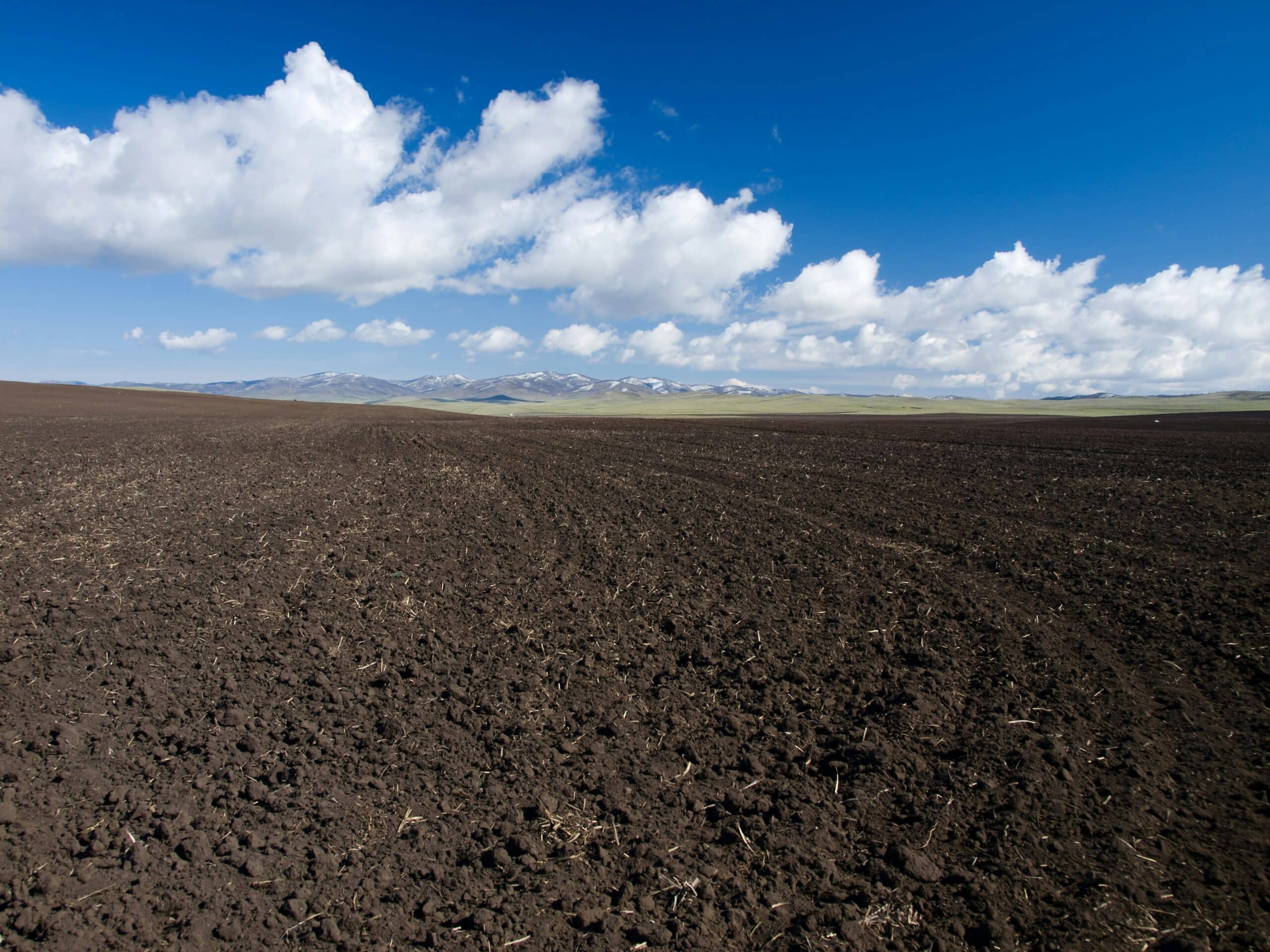
If you’re wondering what the phyllosphere is – you’re not alone. Afterall, the phyllosphere is the least studied of all the spheres. Yet, there’s a lot of new research that examines microbes on the leaf surface and their role in plant health and yield potential.
The findings suggest the phyllosphere microbes are a plant’s first line of defense. The health of the phyllosphere impacts many ecological functions like longevity, fruit development, and growth. Ultimately, growers should support beneficial microbes in the phyllosphere, which can impact plant and crop success during the growing season.
Here’s everything you need to know about the phyllosphere.
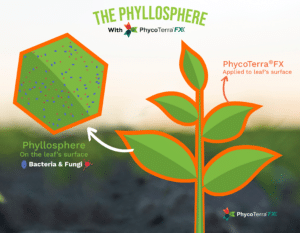
The phyllosphere is a microscopic region around the leaves and above ground tissue of the plant where microbes live. It’s home to many microbes, like non-pathogenic bacteria and fungi. There are up to 1 to 10 million bacteria in a cm2 of leaf surface. That’s less than the rhizosphere, but still a lot of potential to harbor microscopic life.
The phyllosphere is distinct and also interrelated with the other spheres. The spermosphere interacts with the rhizosphere, and both these spheres shape the phyllosphere. The phyllosphere is one of the most dynamic regions given it’s the only sphere with direct interaction with the atmosphere, plant, and microorganisms.
It is estimated that the total leaf surface area that is colonized by microbes is about 640 million per km2.
The phyllosphere acts as a barrier of protection against the outside world for your plant. Leaf microbes help manage different abiotic stressors like UV, moisture, and heat stress. By managing these environmental impacts to the leaves, this sphere becomes a key driver in photosynthesis, biomass and reproduction.
The microbes on the leaf surface are supporting your plant despite a very unstable environment. From a limited food source to harsh conditions, it’s difficult for anything to thrive in the phyllosphere. Microbial communities can change in as little as one day.
Recent studies also suggest a healthy phyllosphere could create better crop decomposition at the end of the season due to an active microbiome.
Currently, the main role of the phyllosphere is to help your crops respond to abiotic stressors, which can determine the health of your crops and yields.
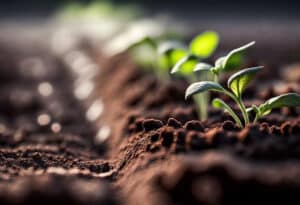
The leaf and microbe interaction is the only sphere that includes interactions between plants, microorganisms and the atmosphere. Leaf microbes are related to plant health primarily via their abundance and diversity. The more abundant and diverse the microbiome at the phyllosphere, the more likely your plants are to withstand abiotic stressors – supporting yield potentials.
This symbiotic relationship exists because leaves provide spacious accommodations for microbes. So microbes, in turn, protect the plant.
Higher levels of abundance and diversity in microbes improve plant health. There’s an increase in nutrient acquisition, a reduction in impact from abiotic and biotic stressors and higher yield potential due to the additional support of the active microbiome. The functions of an active and abundant phyllosphere microbiome also impact include:
Low diversity and abundance in microbes leads to disease and unhealthy plants – impacting yield potential during harvest.
Phyllosphere microbes come from many different places, which is part of the reasons it’s a highly evolving microbiome community.
When you plant a seed, some of the microbes in the spermosphere are transferred to the phyllosphere. These microbes will remain on the leaf and stem of your crop as it grows.
The soil can also transfer microbes to the phyllosphere. Think of your soil as a giant reservoir for microbes. As the plant germinates some of the soil microbes will be transferred to the phyllosphere. When the plant grows, if water splashes on the soil and then lands on the plant, it can also transfer soil microbes to the phyllosphere.
The environment plays a role in your phyllosphere microbiome makeup. Microbes can be transported via the air (when attached to dust or water particles), animals, or insects..
They’re also determined in part by the plant species they inhabit. Each plant has internal tissue (the endosphere) and some of the microbes in this sphere will migrate to the leaf’s outer surface.
Climate and weather conditions also impact the survival, growth, and dispersal rate of leaf microbes. Seasons and temperatures can also impact the diversity, abundance and activity of your phyllosphere.
What’s important to note is that while there are a lot of variables that impact the phyllosphere, growers can also make a positive impact on beneficial microbes. While compost, manure, pesticides, and irrigation can all impact the microbiome, feeding your leaf microbes a carbon food source can make the biggest positive impact on your microbiome and crops.
Supporting your microbes means supporting your yield potential!
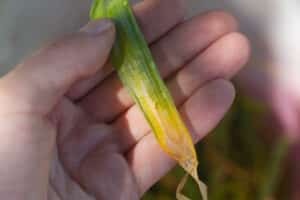
The phyllosphere is not an easy environment for a microbe to thrive in. It’s a harsh, unpredictable territory. As any grower knows, microbes in this sphere may see shifts of pouring rain and soaking wet, cool conditions to 100 degrees and dry an hour later.
Temperature, UV stress, moisture and seasonal changes can all make it difficult for phyllosphere microbes to thrive because of how unstable the surrounding environment is.
Plus, these microorganisms are also impacted by your crop’s growth. They inhabit your plant from seedling to maturity as the cuticle and plant structure changes. Some ways your crops impact this microbiome include:
Microbes have to adapt and change through all that plant growth. One thing that could make those adaptations easier is a stable food source. Unfortunately, the phyllosphere is also a food desert for microbes. While leaves secrete different metabolites to feed the microbes, they have a limited food source on the leaf surface and lack a critical nutrient source.
This is one area where growers can play the biggest role in supporting phyllosphere microbes: By providing them with an adequate food source that supports abundance and diversity, which is where PhycoTerra FX® can help.
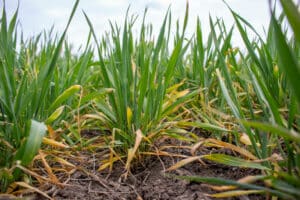
From flooding to droughts, extreme weather events have become more common in recent years. Microbiomes are not immune to these shifts. While there is largely more studying needed to gather a better understanding of extreme weather’s impact on the phyllosphere, what we do know is that these weather patterns don’t make the phyllosphere easier to inhabit. Which is problematic given that it’s already a very difficult place to live.
According to one study, “Global change may influence the phyllosphere microbiome by altering soil properties, microbial communities and plant-soil feedback.” The long-term downward trend of drought frequency and duration impacts agriculture production and the phyllosphere. These dry weather patterns influence plant growth and disease, as well as alter humidity and water availability.
Warming and drought, in particular, can increase stress levels for microbes in the phyllosphere – making it harder for them to survive and support your crops.

All evidence suggests the phyllosphere microbiome plays an integral role in plant health. From reducing abiotic stress to increasing yield potential, an abundant and diverse phyllosphere microbiome could play a pivotal role in your yield potential each year. Healthier plants produce healthier harvests.
Yet, the cards are stacked against the microbes that inhabit the microbiome. Between little food, extreme weather and regular environmental changes, the phyllosphere is not an easy sphere to inhabit.
So how can you, as the grower, support microbes in this sphere? While there are a lot of things that are out of your control, you can control the amount of food the microbes in your phyllosphere get.
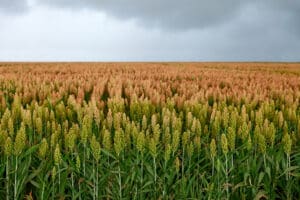
Growers can supply phyllosphere microbes a food source to activate leaf microbes and improve plant health. An active carbon food source increases abundance and diversity and improves your crop’s ability to withstand stressors and drive plant health over time.
Our solution, PhycoTerra® FX is a labile carbon food source. It’s a mix of lipids, proteins and carbohydrates that wakes up microbes so they can support your plants.
By feeding your phyllosphere microbes a labile carbon product foliar application, like PhycoTerra® FX, you can trigger the abundance and diversity response from microbes on the leaf. Some of the benefits of a well-fed leaf microbiome include:
*Microbes secrete EPS with different functionality, which holds in water and creates biofilms for microbes to thrive.
PhycoTerra® FX is a food source that is immediately available to support microbes through stressful times to improve your plant’s abiotic stress response.
From corn to cotton, PhycoTerra® FX helps your plants reach their full yield potential (but especially cotton). Here’s our 2019 – 2023 performance review by broad acre crop.
Crop |
Yield Difference (bu/a or lb/a) |
ROI |
Corn |
+6.4 |
6.1 |
Soybeans |
+2.6 |
6.1 |
Wheat |
+2.7 |
4.5:1 |
Cotton |
+163 |
24:1 |
Canola |
+1.9 |
6:1 |
Sorghum |
+3 |
3:1 |
The phyllosphere is just one microbial ecosystem that needs support from growers. From seed to stubble, healthy and active microbiomes support healthier yield potentials. Here are some of the spheres to consider supporting throughout the growing season.
Spermosphere: The microbes in this sphere are your seed’s first interaction with the real world. By making the interaction a good one and feeding hungry microbes a labile carbon product to supercharge the spermosphere, growers can increase germination, early plant vigor and root system establishment. It also helps provide an even stand.
Rhizosphere: Once your crops are growing, the rhizosphere plays an important role in the plant’s health and success. A healthy and active soil microbiome can support your crops establishment and can improve soil water holding capacity and aggregation. Both PhycoTerra® and PhycoTerra® Organic feed soil microbes, which can improve your yield potential.
Phyllosphere: This foliar application supports microbes on the leaf of your crops. When fed a labile carbon microbial food source like PhycoTerra® FX, you can wake up an abundant and active microbiome to help reduce abiotic stress and overall plant health.
Detritusphere: No one likes pesky stubble. A healthy and active microbiome can help reduce stubble mass and increase temperatures in topsoil temperatures at planting – if a healthy, active and well fed microbe community is present. Consider adding PhycoTerra® to reduce crop residue mass by 23%.
Each sphere is unique and distinct from one another, but their health and activity overlaps and impacts each sphere. There is also an overlap in species, yet each sphere has a distinct group with distinct modes of actions.

Imagine it’s July, and the summer heat is in full force. It gets hot early, it stays hot, and your fields haven’t had a drop of rain in weeks. You’re doing your best to manage your irrigation (if available) and get your crops extra support. Yet your plants aren’t withstanding the heat.
In moments like these you’ll be grateful you invested in your phyllosphere. Providing your crops with extra resilience could be the differentiating factor between a good and great year.
Much of the United State’s is already seeing the beginning signs of a long, hot growing season – from abnormally dry conditions to extreme drought in some states, like in Iowa or New Mexico. A strong leaf microbiome community can provide abiotic stress relief for your crops, allowing them to better manage whatever the growing season may bring and increasing your yield potential.
A strong leaf microbiome can only exist with the extra support of a key food source, made especially for the phyllosphere microbiome.
Want to learn more and ask an expert questions about your specific crops and how PhycoTerra® FX can support your yield potential this year? Fill out a contact form to speak with an expert.
Or, check out these trial crop results to gather more information on how PhycoTerra® FX has positively impacted crops like yours.